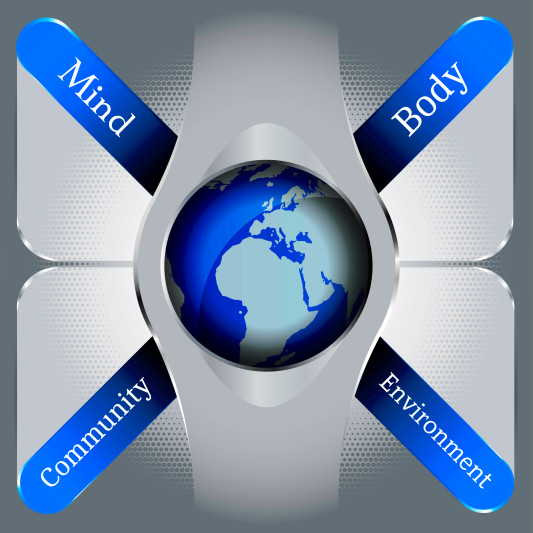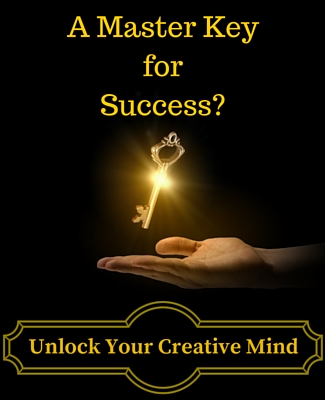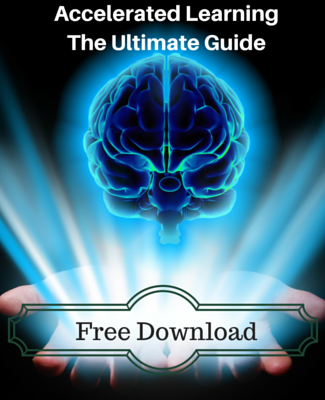The Core Four: Four Parts of Everything

There are 4 distinct features of every situation we will ever be in. They are always present, so understanding them can help us take any area of our lives to the next level: work, study, play, learning, growth, career, or anything else that grabs our interest.
The Core Four:
- Environment
- Social Community
- Body
- Mind
Theories of The Core Four
There are many “Big Picture” theories out there, but they all consistently take these four aspects of reality into account. If they don’t, then they are missing something. And we have yet to find evidence for anything that exists outside of these domains.
We don’t have time to explore all these theories right here, but if you’re interested in digging deeper, you might start with these 7 Treasures More Valuable than Gold.
Briefly, Ken Wilber’s Integral theory and his book A Theory of Everything is a good place to start. His work dives into these in depth with his AQAL map.
You can also see evidence for these in the most comprehensive medical model for holistic health: the Biopsychosocial model. It posits that to understand health or sickness, we need to consider factors from biology, psychology, social relations, and environmental factors.
And even when we look to ancient philosophies from the western intelelctual tradition, to the 8 limbs of Yoga, or even Buddhist philosophy, we find that some deal with the environment, others with our social community, others with the body, and also the mind.
For now let’s just explore how we can put these ideas to use.
Leveraging Alignment
The real magic of life happens when we get these four domains in alignment. This is how we can create the optimal conditions for flow, health, creativity, productivity, well-being, and simply enjoying ourselves.
When things aren’t going our way, since these four domains encompass literally anything that could be affecting our situation, they offer a tool for us to find the hidden problem and to set things straight.
Long story short: the Core Four give us a lens that can help us thrive in any endeavor and offer us a tool to find out what’s missing or how we might make improvements.
Digging Deeper: Environment
The environment represents the most expansive sphere. This is everything relating to the setting around us and the resources within that setting. Thus it encompasses the entire physical universe, and it includes everything up to the room or place where we find ourselves right now.
Want to find the environment, then just look around you. But this isn’t limited places. It also includes all the resources or other factors that are inside the space we’re considering.
For example, my present environment includes this universe, the Earth, Japan, Niigata city, the house where I’m living, the room I’m in, the desk I’m working on, and the computer under my fingertips (not to mention my chair, the air around me, my reference books, and my wireless router, etc).
When we think of environment we could substitute the words: objective physical universe and all the things inside of it. Obviously the things closer to us have a greater immediate impact on what we’re doing.
Social Group
Inside the environment, there are groups of people. This could be our country, community, neighbors, family, friends, or if I’m alone it comes down to just me.
But whether I’m alone or not, social group is a significant factor in the immediate situation. For example, I like to write in a quiet place. If I was in an active daycare where there were 20 small children laughing, crying, and playing all around me, this would affect my work (probably negatively).
If I’m learning a new skill, it helps to have a teacher, mentor, peer, or coach around. Any of these people can help me learn more quickly depending on how we interact with one another. Furthermore, even when we’re alone, much about us has been conditioned through our social community: our sense of right and wrong, cultural norms, and many preferences developed just so because of social influence.
Body
Inside that social community is, well… ourselves. And it’s helpful to consider us as individuals on two levels since we can’t reduce what happens in the mind to the physical processes of the body. (We’ll consider how the Core Four all influence each other below.)
Our DNA, body type, natural energy levels, current health, and fitness set the tone for how we experience everything. They influence how often we get sick, what time of day we work best, and our physical limitations. All of these influence how well we do when it comes to work, learning, relationships, and more.
If, for example, you find yourself extremely tired all of the time, then it’s unlikely that you will feel inspired to practice your favorite hobby when you get back from a long day’s work.
By contrast, if you have physical resources to spare at the end of the day, then there is no telling what you might do with that abundance of energy.
Mind
Here we’re talking about everything you think, feel, believe, your orientations towards life, your knowledge, ability to learn, ability to focus, your sense of self (that feeling of “I am”), and much much more. This is the world of psychology, philosophy, spirituality, and the experience of existing.
The mind represents everything that we can’t see by simply scanning your brain. You might imagine a picture of a gorilla in a pink tutu. In your mind, you can see an image. But if we scan your brain, all we get is a reading of electrical conductivity in a certain region.
That picture happens in the mind.
Nothing is Independent
The key here is that the Core Four are not actually distinct or separate entities. They all affect each other constantly. In Buddhist Philosophy, one might say that they all condition each other.
Consider our food preferences:
Some people are vegetarians, some people enjoy fresh monkey brains straight from a skull that’s just been bashed open in front of them. Many other people fall somewhere in between.
Whether you consider monkey brains to be grotesque and immoral or a delicacy certainly depends on where you come from, when you were born, the culture of the people around you, your place in that society, how your tastebuds respond to monkey brain, and a lot more.
The interdependent nature of the Core Four is one reason that Ken Wilber calls his “Theory of Everything” Integral Theory.
All parts of reality are integrated, nested within each other. None of them are independent. Both up and down, they all influence one another.
Actionable Takeaway
Consider an aspect of your life, an area where you would like to see change or improvement.
Then consider how the Core Four affect your performance or outcomes with that activity. For example, if you are working on health and fitness (an area where most of us have room for improvement), consider the following:
Environment – What place is ideal for your progress? How much space do you need? What resources are required? Is it better to be inside or outside? Are you currently limited in any way by the type of space or resources that are available to you? How can you fix this?
Social Community – Do other people help or hinder your performance? Do you know anyone who has the success you’re looking for? What are they doing? Could you get there advice or guidance? Would it help to hire a coach?
Body – How does your body fit into this role? Do you have the energy you need to do the work you want to do? Do you have an injury that you need to rehabilitate in order to accelerate your success? What sort of foods are good for the changes in body you seek? What foods hinder that progress?
Mind – How do your attitude, knowledge, and beliefs affect this picture? Are you optimistic or pessimistic about your learning? Can you find the mental resources to motivate yourself to exercise even when you don’t feel like it? Do you feel pouty about having to go to work or are you excited to get things done? Do you focus on the pain of work or on the pride and pleasure in overcoming your resistance?
Whenever you need a boost, you can use the Core Four as a lens to uncover the hidden obstacles that may be slowing you down.
Leverage these domains whenever you consider a part of your life that really matters to you. With this tool, you’ll have have a step and a jump on anyone who hasn’t noticed the interrelation of these factors.
If you enjoyed this article or have any questions or comments, I’d love to hear from you.



[…] we do something, we’re influenced by countless variables around us, The Core Four. So by taking just a little time to set up a solid system, you can save hundreds or even thousands […]